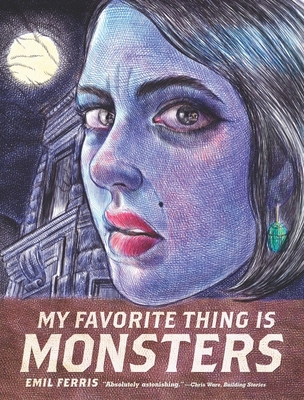My Favorite Thing Is Monsters, Vol. 1
Emil Ferris

First, a warning: this book is emphatically “Vol 1” like it says on the tin. At the end of the book, there will be more questions and mysteries in your mind than at the beginning, and Vol 2 is not scheduled to be released until August 2018! I’m eagerly awaiting its publication to continue following the mystery-solving adventures of Karen Reyes. My only complaint is that it’s too big to read on the subway, but I think it’s the right size to allow the artwork space to breathe (and I read it in a couple of days anyway).
This book is incredibly rich, and is successful at justifying its existence as a graphic novel as opposed to just a regular novel (though I think it would also be pretty good as the latter). It is also much more adult than I expected when I picked it up–not in terms of sex (though there is some of that), but in terms of confronting a wide variety of really difficult issues, and at times going to some very dark places. I thought it was going to be a book about a kid who pretends to be a werewolf, and it is that, but it’s also a book about the Holocaust, homosexuality, class privilege, racism, grief, and art. Both Karen, the protagonist, and her older brother Deeze (Diego Zapata) are quite memorable characters who guide us as readers through their very challenging world without a hint of self-pity and with a great deal of humor (I still find myself laughing thinking about the Zarnov P. Zarnoff award). The book may also make you rethink your perspective on monsters, especially Medusa!
Ferris’s illustrations in the book are also an integral part of the story. There are two key visual themes running throughout MFTIM: first, pulp horror magazine covers, which Karen carefully draws in her notebook and which serve as chapter dividers; second, paintings from the Art Institute of Chicago. The story takes place in Chicago and the AIC is an important place for Karen and Deeze, who are both artists. Events in the story will often remind Karen of a painting, which she reproduces in her notebook, and there are some creepy and striking scenes of Karen entering into the world of a painting and conversing with characters there. While a lot of the book is illustrated in the more pulpy style, with lurid color schemes, that Karen is most comfortable in, Ferris also includes some very realistic and intimate portraits of individual faces–mostly of Anka Silverberg (shown on the front cover), but sometimes of others as well.
The book as a whole has an engaging mystery-based plot, but more than that, is a deeply humanist portrayal of lives in two societies in the process of upheaval.